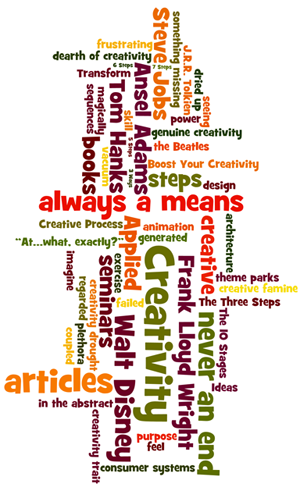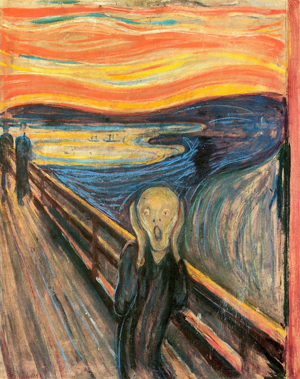Help! We Have a Creativity Famine!
Creativity—Always a Means, Never an End
A quick Google search for “steps of creativity” turned up a plethora of Web articles. Here’s a sampling:
- 7 Steps to Creativity—How to Have Ideas (writetodone.com)
- The Three Steps to Creativity: Copy, Transform and Combine (Lifehacker—Australia)
- The 10 Stages of the Creative Process (brainpickings.org)
- 5 Steps that will Boost Your Creativity (edudemic.com)
- 6 Steps to Get Unstuck and Get Your Creativity Flowing (oprah.com)
- 3 Ways to Be Creative (wikiHow)
 Just from the sound of these titles—without having read the articles—it would seem we could venture a couple of assumptions about creativity:
Just from the sound of these titles—without having read the articles—it would seem we could venture a couple of assumptions about creativity:
- There seems dearth of creativity “out there,” a creative famine! and the writers of these articles want to help with that pressing problem.
- That the missing creativity trait can be generated magically by merely following the 3, 5, 6, 7, or 10 steps provided.
Does anyone see anything wrong with this picture?
Creativity, such as found in Walt Disney, Steve Jobs, Frank Lloyd Wright, Tom Hanks, the Beatles, Ansel Adams, or J.R.R. Tolkien is highly regarded and in great demand. But, is there an international “creativity drought”? Are we in desperate need of new sources of creativity because our usual sources have dried up? I think, rather, it is all around us, though it may be underappreciated. We’re just not seeing it.
Most of the books I’ve read and seminars I’ve attended on the subject of “creativity” follow one of the sequences above, or ones very much like them. In attending one of these seminars, or in the reading of these books, though there have been some things of value, I have never failed to feel that there was something missing.
It took me a while to figure out what it was. Then it dawned on me: genuine creativity is always a means, never an end. To train or write about creativity in the abstract, without application to a specific something, can be a hollow, frustrating exercise. When I read a promotion stating, “You too can learn to be creative!” I can hardly keep from adding, “At…what, exactly?”
Creativity rarely occurs in a vacuum. It is always applied to something. Disney’s creativity was in animation and theme parks, Jobs’ in consumer systems, Wright’s in architecture, Hanks’ in movies, etc. Flexing your “creativity muscles” may not be a bad thing by itself, but imagine the increased power of that skill when coupled with purpose!
(And by the way, at least one form of applied creativity is called design.)
Creativity’s Greatest Hurdle: Fear
If there were a dearth of creativity in the world, how would we best conquer it? What keeps creativity from happening?
Contrary to the wisdom of the Web, it is not usually because we don’t know the steps necessary to bring it off. I believe most people are naturally creative, if they let themselves be. Rather, creativity is thwarted because it has been frozen by fear.

Fear keeps us from creating
(“The Scream,” 1893, by Edvard Munch.)
Fear is the great stumbling block of creativity.
Here are three kinds of fear that frustrate creativity, though I’m sure there are more.
The first is catagelophobia: fear of being ridiculed (literally, of being laughed at). If it rises to the order of a serious condition, it might be what psychologists refer to as “social anxiety disorder.”
Another fear is atychiphobia: the fear of being wrong. This is probably related to the paralyzing malady more commonly known as perfectionism.
Finally, probably related to of all obstacles to creativity—and usually co-morbid with them—is the fear of starting, better known as procrastination.
All of these fears seem to point to an over-concern with self—a fear of others’ opinions, a fear of being wrong, or a desire to do what one wants rather than what is needed.
For example, if its source is extrinsic, an over-abundance of so-called “confidence” could actually be a detriment to creativity. When that is the case, contrary to appearances, it is arrogance or vanity, which may be overcompensation for a lack of confidence rather than evidence of an abundance of it. Unhealthy pride and vanity are afflictions of the weak and the wary, not the willing.
Procrastination is often manifest as “waiting for the right (time, mood, conditions, etc.)” However, as often as not, if we’re honest with ourselves, those conditions, never arrive. Instead, we end up postponing the action until it becomes either a crisis or becomes irrelevant. In a crisis, actions are driven by panic and adrenalin—often rushed, with the attendant hazards. Or, if the action is no longer relevant, it either never was, or else we ourselves are in danger of becoming irrelevant.
Self-assurance, the sense that the self has intrinsic value, is the nursemaid to creativity. Self-assurance plows the ground in preparation for creative thought; courage prepares us to follow-through with action. Creativity demands both. Walt Disney knew this:
Somehow I can’t believe that there are any heights that can’t be scaled by a man who knows the secrets of making dreams come true. This special secret, it seems to me, can be summarized in four Cs. They are curiosity, confidence, courage, and constancy, and the greatest of all is confidence. When you believe in a thing, believe in it all the way, implicitly and unquestionable.~Walt Disney, emphasis added
So the cure is not to find the right “situation,” where threats and impediments are non-existent. Rather, it is to find a way to crawl out of selfish concerns, so that our curiosity, confidence, courage, and constancy can cause our creativity to flourish.
© Copyright 2014 by S. Todd Stubbs. All rights reserved.

